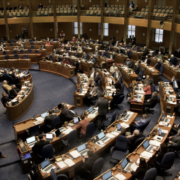How would you feel if your season was taken away from you in a blink of an eye? Not having any control over what is going on. Having your voice not heard. It’s happening, and athletes worldwide have been (and many still are) in shock.
Sports seasons have been cut short and pushed back due to COVID-19. There’s more, too.
How would you feel during a pandemic–returning to campus while having a season to play? How would you feel, worrying constantly about your health while attending class and engaging in workouts?
In response, the NCAA announced regulations giving athletes a choice. Because of COVID-19, student-athletes have an opt-out alternative. If student-athletes take it, then schools are required to honor scholarship commitments. Having that option gives athletes the ability to focus on their health.
But that choice has implications. If too many student-athletes in a sport choose to opt-out, a season could be on the brink or ended. On the other hand, research isn’t available yet regarding the long-term effects of COVID-19. What we do know is this: the disease will put you out for two weeks and cardiologists are warning about the possibility of serious heart issues afterward.
That prospect scares me as an athlete. Most athletes are in great shape–never thinking that something like that could happen. So would you risk your health for one season?
On the other hand, there’s a stark alternative–no college sports until COVID-19 passes–and the financial implications that come with it. For revenue-generating sports, playing games yields money. And there’s the issue of fans attending games. Fans equal money. No fans equal no money. Athletes want their fans in the stands, of course, but fans attending games can increase the likelihood of virus-spread. And for athletes, playing could bring a spike in COVID cases.
And what about the schools? They need students to generate tuition dollars and other forms of revenue. The main issue for schools is whether to have students on campus or go primarily (if not exclusively) online. Some schools have switched back and forth based on COVID-19 spread, while others have closed for good. MacMurray College and Franklin University are two.
Major universities have been affected, too, having to tighten athletic spending, including cutting sports teams to stay in the black. Stanford cut one-third of its men’s and women’s sports, including several Olympic sports. The University of Kentucky, like many others, announced significant declines in athletic revenues. In UK’s case, it’s about $70 million. And no small matter for many schools is the revenue lost from canceling basketball’s March Madness 2020.
But, for me, I come back to the student-athlete. According to the NCAA, there are 460,000 student-athletes enrolled at America’s colleges and universities. What’s the best path for them?
As much as I and many others would like to start the season and resume regular college sports action, doing that isn’t right. There’s a bigger challenge before us. With no idea of the path ahead in terms of personal health and our country’s public health, we need to do what we can–all of us–to prevent future cases and halt the spread of this deadly disease.
But here’s the thing: the decision-makers who’ll make the call aren’t student-athletes. There are not the ones putting their health on the line to play a sport. For me, that makes the right call pretty clear.



